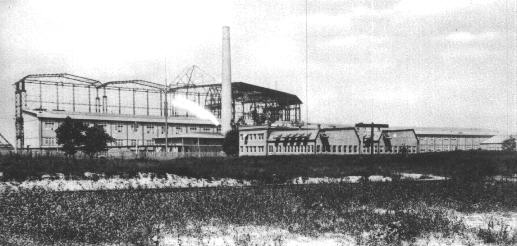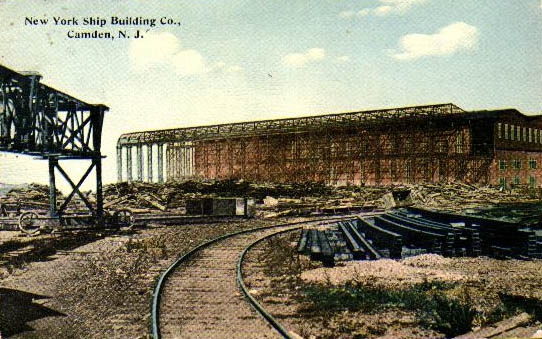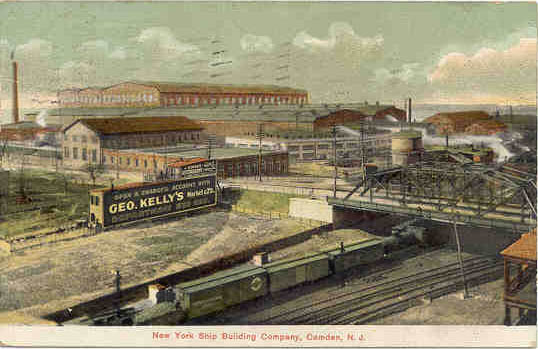 A Place Called YORKSHIP - History
of New York Ship
A Place Called YORKSHIP - History
of New York Ship A Place Called YORKSHIP - History
of New York Ship
A Place Called YORKSHIP - History
of New York Ship
[The following is excerpted from 50 Years: New York Shipbuilding Corporation, published by NYSB in 1949]
THE BEGINNING
THE New York Shipbuilding Corporation was organized in 1899. The original plan was to build the new plant on Staten Island, and the company which was formed was therefore called the New York Shipbuilding Company. Inability to acquire the desired site, however, necessitated a survey of other locations down the coast as far as Virginia. The result of investigations by several inspection parties was the purchase of a tract of approximately 160 acres on the east side of the Delaware River in the southern part of the city of Camden, New Jersey, across the river from Philadelphia. The ground conditions were especially suited to the building of shipway foundations, and railway facilities were adequate. Time has shown the selection to have been a good one.
 At the outset it was decided to break away
from the old century's accepted traditions of shipbuilding and
build a yard in which could be applied the most up-to-date
labor-saving machinery and advanced methods of structural steel
construction. The planning and opening of the New York
Shipbuilding Company yard was due mainly to the foresight and
energy of the late Henry G. Morse, its first president.
At the outset it was decided to break away
from the old century's accepted traditions of shipbuilding and
build a yard in which could be applied the most up-to-date
labor-saving machinery and advanced methods of structural steel
construction. The planning and opening of the New York
Shipbuilding Company yard was due mainly to the foresight and
energy of the late Henry G. Morse, its first president.
Mr. Morse, who had resigned from the presidency of the Harlan and Hollingsworth Company, of Wilmington, Del., to form the new shipyard, was the guiding force throughout "New York Ship's" organization. He survived the completion of the yard and the delivery of the first nine ships. Up to the time of his death he had secured for his company twenty contracts. Among these was the armored cruiser WASHINGTON, first Naval vessel ordered from New York Ship.
Ground was broken for New York Ship on July 3, 1899. Contracts for preliminary work and equipment for the yard were let within a month. On June 15, 1900, in the sixth month of the new century and the twelfth month of the new yard, the contract for New York Ship's first vessel was signed. On November 29, 1900, the keel was laid.
There were five basic objectives followed in the designing and laying out of the new shipyard. Mr. Morse's advanced ideas were the basis of the planned shipbuilding procedure which he contributed to the industry throughout the world. They were largely the result of his extensive structural steel fabrication experience prior to entering the shipbuilding field.
 First,
the application of the mold loft template system for the
fabrication of hull steel--a pioneer undertaking for shipbuilding
at that time but now standard practice in the industry.
First,
the application of the mold loft template system for the
fabrication of hull steel--a pioneer undertaking for shipbuilding
at that time but now standard practice in the industry.
Second, provisions for prefabrication of relatively large structural assemblies and continuous routing of material from receipt through fabrication shops and on out to the shipways, a method widely publicized as a new development during World War II.
Third, an unusually complete overhead crane system for handling prefabricated structural assemblies up to 100 tons weight.
Fourth, a coordinated series of shops with five large building ways, and an outfitting basin completely roofed over and served with overhead bridge cranes.
Fifth, installation of propelling machinery and other heavy weights before launching, by providing 100-ton crane capacity over all the building ways.
Of these five objectives, the first--the application of the template system--was perhaps the most revolutionary. In the half century that has elapsed since its introduction by New York Ship this system has come to be standard practice, but in 1900 it was looked upon with grave misgivings.
This system permitted the continuous fabrication of steel from mold loft development of plans which did away with the previous practice of "lifting" templates from work in place before the shop could function. Through accurate mold loft development of templates from plans, the shops are enabled to go ahead with their work for any part of the ship upon receipt of material with the assurance that when a particular part is wanted by the ship erectors, it will fit its appointed place.
It was because of New York Ship's experience with these advanced practices that the yard was asked to supervise the designers who laid out and planned the Hog Island yard. New York Ship produced the original templates for the vast fleet of ships built at Hog Island in World War I and assisted in the development of templates for other vessels assembled elsewhere.
THE FIRST SHIPS
THE first twenty contracts built
by New York Ship were secured during the lifetime of its founder.
Concluded over only a three year span, these contracts included
ships of six major types: the tanker, the cargo vessel, the
passenger ship, the warship, the river boat and harbor craft. In
the first half century of its existence, New York Ship  has continued to build ships of each of these major
categories. The first ship built by the new yard was the oil
tanker J. M. GUFFEY. Two other tankers were among the first
twenty contracts. Through the fifty years to come, tankers
continued an outstanding product of this Yard.
has continued to build ships of each of these major
categories. The first ship built by the new yard was the oil
tanker J. M. GUFFEY. Two other tankers were among the first
twenty contracts. Through the fifty years to come, tankers
continued an outstanding product of this Yard.
There followed three cargo ships built for the famed intercoastal service operated by the American Hawaiian Steamship Co. All three of these large freighters saw service in World War 11, although nearly twice the age of the average cargo ship at the time of Pearl Harbor.
Contracts 5, 6, 7 and 8 were for four large combination passenger and cargo liners. Outstanding in this quartet were the MONGOLIA and MANCHURIA, 16,000-ton liners built for trans-Pacific service. Among the largest ships ever built for the American Merchant Marine, both saw service in two wars.
Few ships have ever so successfully served such a variety of routes. Although laid down for trans-Atlantic trade, they were first used as trans-Pacific liners. Pressed into service in World War 1, to the MANCHURIA went the honor of firing the first shot at a German submarine. After the war the 615-foot sister ships operated on the then-new intercoastal run. Sold to other interests they next found themselves with new names on round-the-world cruise service. Again called into transport duty, both ships survived World War II. Although the MONGOLIA was scrapped in China in 1947, the forty-five year old MANCHURIA is still in profitable operation as the SANTA CRUZ, running between Europe and South America.
 New York Ship's contracts 9 and 10 were oil tankers,
the LIGONIER and LARIMER. These were followed by barges and the
fireboat ABRAM S. HEWITT, built for the City of New York and
still protecting water craft and piers in the world's greatest
seaport.
New York Ship's contracts 9 and 10 were oil tankers,
the LIGONIER and LARIMER. These were followed by barges and the
fireboat ABRAM S. HEWITT, built for the City of New York and
still protecting water craft and piers in the world's greatest
seaport.
New York Ship's fourteenth contract was the cruiser WASHINGTON. Competition for the ship was keen. In awarding this contract to a new yard the Navy knowingly risked criticism. Despite many expressions of doubt regarding the ability of New York Ship to perform the work promptly and properly the cruiser was delivered on July 30, 1906, ten days ahead of contract time. The WASHINGTON made 22.27 knots on her speed trials, and was the fastest ship in the Navy, of that period. Not since February 10, 1903, when this historic contract was signed, has New York Ship been without Navy work.
The remaining ships of the Morse era were two dredges, another New York City fireboat, two car floats, and the ONTARIO, an east coast passenger liner. In this short period, New York Ship had been awarded contracts by the Army, the Navy and the City of New York in addition to those by private rail, oil and ship operators.
Henry Morse died in 1903, and control of the company passed to former general manager De Courcy May. The greatest challenge to the company during May's tenure (1903-1913) was obtaining repeat and multi-ship orders which would allow it to enjoy the efficiencies of the Morse template fabrication system. Most commercial ship owners in this period continued to prefer custom-built vessels. However, New York Ship did secure contracts from Gulf Oil for four 407-foot tankers, from Standard Oil for four Rayo-class tankers, and from the U.S. Lighthouse Department for ten lightships (five each of two designs) and five lighthouse tenders.
But it was naval contracts--in particular for battleships--which secured the shipyard's future, beginning with the Michigan in 1906 (Michigan's twin South Carolina was built across the river at Cramp). In 1908 May won the contract for the Utah with a bid of $3.95 million and a promise to deliver her in 32 months. In 1909 New York Ship was awarded the Arkansas, in 1910 the Moreno (as a subcontractor to Bethlehem Steel), and in 1912 the Oklahoma. According to Thomas Heinreich, "New York Ship emerged as the nation's principal battleship builder during the dreadnought era."
In 1916 the shipyard was acquired by American International Corporation and the steamship line W.R. Grace.
![]() your
Yorkship memories to Michael
Kube-McDowell, Class of '68
your
Yorkship memories to Michael
Kube-McDowell, Class of '68